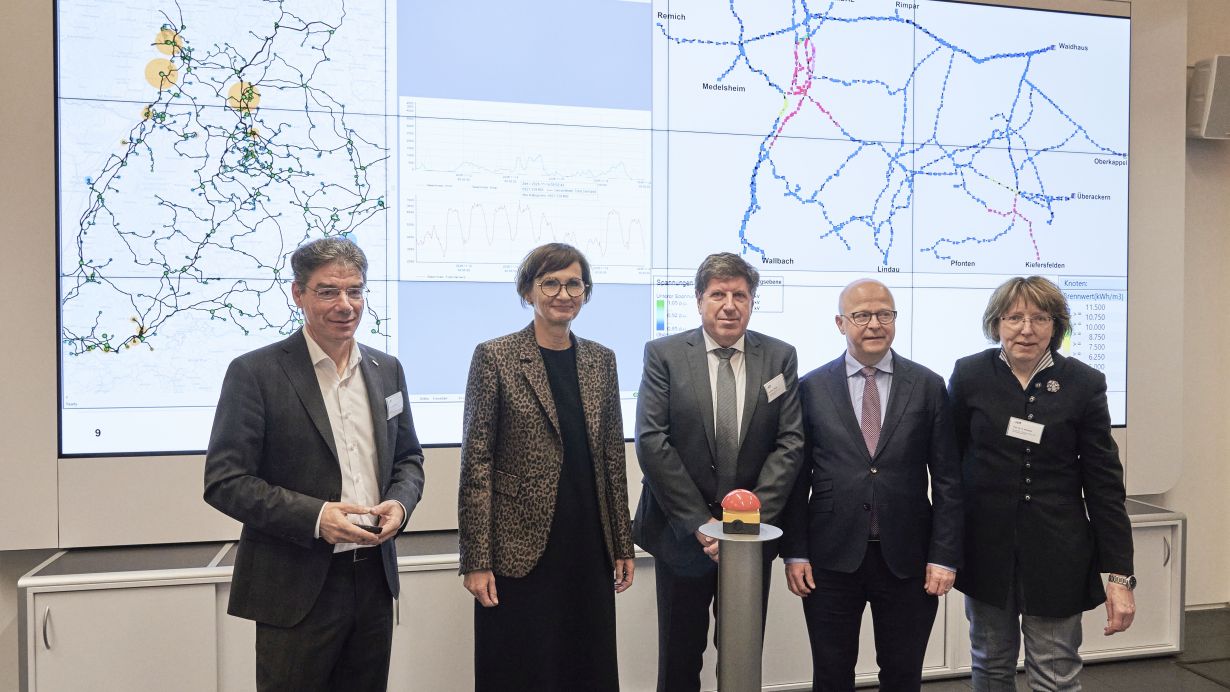With the goal of climate neutrality in mind, researchers of Energy Lab 2.0 of Karlsruhe Institute of Technology (KIT) have built a detailed “digital twin” of the German energy system. It integrates real technical plants, such as a solar park, grid storage systems, and power-to-X facilities, and can now be used to virtually test the future energy system with all its components. Today (October 28, 2022), Federal Research Minister Bettina Stark-Watzinger started the simulation during her visit of KIT.
The Minister was accompanied by Michael Theurer, Undersecretary of State with the Federal Ministry for Digital and Transport.
Research at Energy Lab 2.0 is aimed at finding out how a climate-neutral and resilient energy system should be designed and how it can be controlled safely and reliably. The simulation is based on renewable energy sources and a closed carbon loop, that is on the energy system the Federal Government plans to establish by 2045. A large part of the work at Energy Lab 2.0 is funded by the Federal Ministry of Education and Research (BMBF).
“Progressing climate change and the energy crisis clearly show that we have to speed up the transformation of our energy supply system,” said Federal Research Minister Bettina Stark-Watzinger. “To reach our ambitious goals, we rely on extensive research. Energy research here at KIT and in the Helmholtz Association decisively contributes to accelerating the energy transition and to specifically developing future energy supply based on green hydrogen, for instance.”
“With our Energy Lab 2.0, we can show that a climate-neutral energy system will be feasible in future,” said Professor Thomas Hirth, KIT Vice-President for Transfer and International Affairs, who welcomed the guests on behalf of the Executive Board. “Although Germany will probably always remain a country dependent on importing energy, we can provide the technologies and develop the know-how needed for implementing a climate-neutral energy system on the national and international levels. Energy research here at Energy Lab 2.0 is a good example of how close science is to practice and how science addresses the big challenges of our time in a practically relevant way.”
Energy Lab 2.0: Test Field for Sector Coupling
Energy Lab 2.0 is Europe’s biggest infrastructure for research into renewable energy sources and sector coupling. The highly performing models developed here are used to realistically simulate the flexible interaction of electrical, thermal, and chemical energy carriers. Here, smart connection of future hydrogen infrastructures or planned wind parks with real power-to-X plants, energy storage systems, and other energy system components is trained. The Lab includes a solar park and a geothermal plant as well as innovative energy storage systems, power-to-X plants, residential houses, electric cars, and very large computers. In the next years, a new generation of experts will be trained to operate the future energy system and to successfully cope with periods of little or no wind and solar power production and attacks of cyber criminals.
Speeding up the Energy Transition
Research at KIT’s Energy Lab 2.0 extends from basic studies to prototype development. Plants for fuel production based on renewables and ambient CO2, redox flow storage systems, or fabrication strategies for various key components are developed to maturity in cooperation with industry. Industry is also invited to use the sophisticated simulation tools and test self-developed energy system components in a realistic environment. Politics can use Energy Lab 2.0 as a real-world lab: Here, it can be studied quickly how lacking gas supplies from Russia can be compensated by renewable energy sources or savings and how a ramp-up of hydrogen economy can be organized technically.
Further Information: https://www.elab2.kit.edu/
More about the KIT Energy Center: https://www.energy.kit.edu/
Detailed figure caption:
Start of the simulation at Energy Lab 2.0 (from left to right): Professor Michael Decker, Head of the KIT Division of Informatics, Economics, and Society; Bettina Stark-Watzinger, Federal Minister of Education and Research; Professor Thomas Hirth, KIT Vice-President for Transfer and International Affairs; Michael Theurer, Undersecretary of State with the Federal Ministry of Digital and Transport; Professor Andrea Robitzki, Head of the KIT Division of Biology, Chemistry, and Process Engineering. (Photo: Amadeus Bramsiepe, KIT).
In close partnership with society, KIT develops solutions for urgent challenges – from climate change, energy transition and sustainable use of natural resources to artificial intelligence, sovereignty and an aging population. As The University in the Helmholtz Association, KIT unites scientific excellence from insight to application-driven research under one roof – and is thus in a unique position to drive this transformation. As a University of Excellence, KIT offers its more than 10,000 employees and 22,800 students outstanding opportunities to shape a sustainable and resilient future. KIT – Science for Impact.

